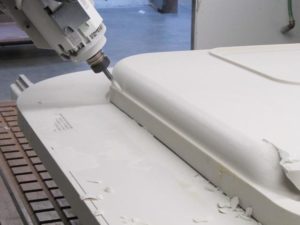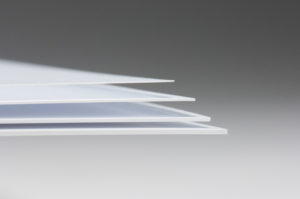HIPS (High Impact Polystyrene), also known as PS (Polystyrene), is an amorphous thermoplastic material, used in lower heat applications. It is categorized as a standard material, and offers ease of processing, high impact strength, and stiffness.
Benefits of High Impact Polystyrene (HIPS)
High impact strength
Can be printed using Digital, Screen, Flexo, and Litho inks
Fabricates well – can be guillotine cut, die-cut, punched and formed
Easy to Thermoform
Good dimensional stability
Fully recyclable with minimal loss of properties
FDA approved with 100% virgin resin
Technical Resources
- Polycarbonate vs. Acrylic vs. Glass: What’s the Best Fit for Your Project?
- PVC vs CPVC: Which Is Better?
- Polypropylene vs. Polyethylene: How Do They Differ?
- Thermosets vs Thermoplastics: How They Differ
- Homopolymer vs Copolymer
- Plastics Pyramid
- Amorphous vs Semicrystalline
- Fiber Reinforced Panel Alternatives
- How To Choose the Right Plastic for Your Project
- LEXAN™ CLINIWALL™: Next Generation Wall Cladding
- BioPhorum, Polymershapes, and the Future of Material Sterilization
- Design for Manufacturability and Its Importance
Common Applications
Physical Properties
| Units | ASTM Test | High Impact Polystyrene | |
|---|---|---|---|
| Tensile strength @ break @ 73°F | psi | D638 | 2,480 – 4,520 psi |
| Flexural modulus @ 73°F | psi | D790 | 193,000 – 381,000 psi |
| Izod impact (notched) | ft-lbs/in of notch | D256 | 1.2 – 2.8 ft-lbs/in of notch |
| Water absorption @ 73°F – 24 hours | % | D570 | 0.036 – 0.11% |
| Coefficient of linear thermal expansion (CLTE) | (in/in F) | D696 | 5.0E-5 to 5.1E-5 (in/in/°F |
| Heat deflection temp. @ 264 psi | 160° – 189° F (71° – 87° C) | D648 | 160° – 189° F (71° – 87° C) |
* Technical Data is provided courtesy of UL Prospector (www.ulprospector.com) and IAPD (www.IAPD.org).
Data is to be considered representative and is provided for guidance only. All product performance must be verified by the user under actual application conditions.

 POP/Display
POP/Display
 Printing/Graphics
Printing/Graphics
 Prototyping & Tooling
Prototyping & Tooling
